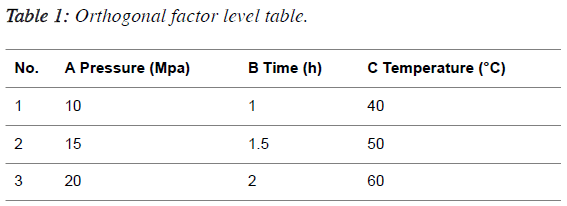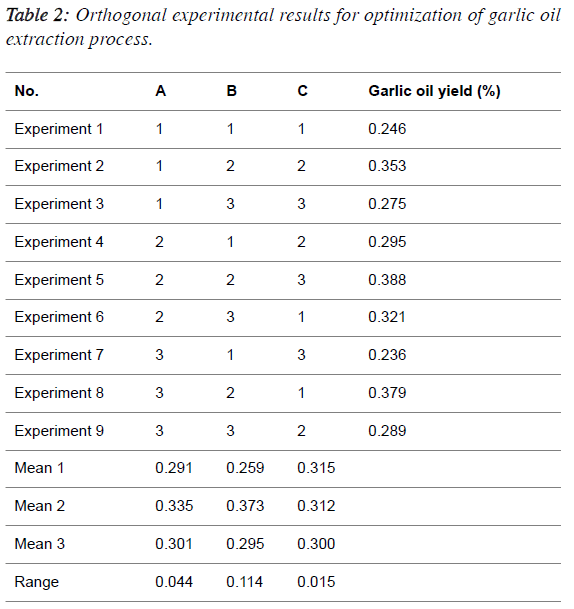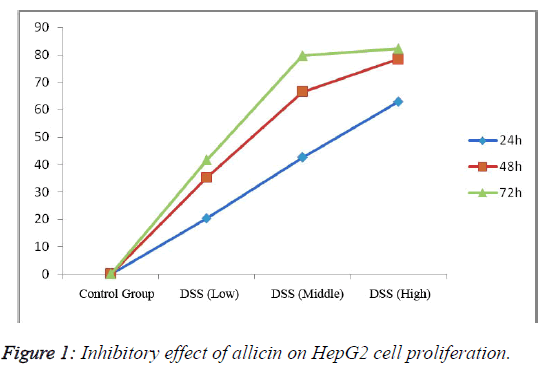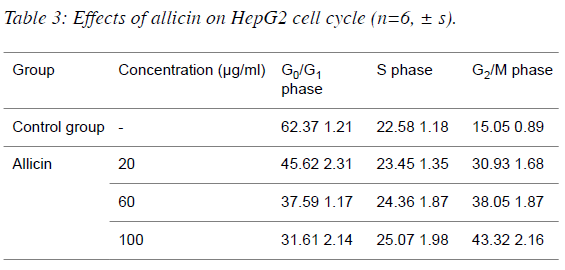- Biomedical Research (2016) Volume 27, Issue 1
Anti-proliferative effect of allicin on human hepatoma HepG2 cells.
| Hailin Ye, Guanxiong Ye, Jinyan Jiang, Xiaoya Xu, Chengjun Wu* Department of hepatobiliary and pancreatic surgery, Lishui People’s Hospital, Zhejiang 323000, China. |
| Corresponding Author: Chengjun Wu, Department of hepatobiliary and pancreatic surgery Lishui People’s Hospital Zhejiang 323000 China. |
| Accepted Dec 09, 2015 |
Abstract
To investigate the factors influencing the supercritical CO2 extraction of garlic oil, and to explore the inhibitory effect of allicin on human hepatoma HepG2 cell growth. Appropriate combination of process parameters for supercritical CO2 extraction of garlic oil was identified through orthogonal experiment. Human hepatoma HepG2 cells were cultured in vitro, and changes in growth of allicin-treated HepG2 cells were determined by MTT assay and flow cytometry. Optimal experimental conditions for supercritical CO2 extraction of garlic oil were extraction pressure of 15 Mpa, extraction duration of 1.5 h, and temperature of 40°C. Cell cycle analysis by MTT assay and flow cytometry showed that allicin had a marked inhibitory effect on growth of HepG2 cells, which increased with increasing allicin concentration and treatment time. Under inverted microscope, the allicin-treated HepG2 cells exhibited reduced intercellular junction and cellular shrinkage. With increasing concentration of allicin, changes in the intercellular junction and cellular morphology became increasingly evident. Most cells were detached; chromatins were condensed, compacted and split into clumps; and typical apoptotic characteristics such as apoptotic bodies emerged. Allicin has a certain inhibitory effect on growth of human hepatoma HepG2 cells.
Keywords |
| Allicin; Supercritical extraction; HepG2 cell |
Introduction |
| Garlic is the bulb of Liliaceae Allium plant garlic, which is warm, pungent and has anti-bacterial, anti-inflammatory, winddispelling, anti-dysenteric, carbuncle-resolving and disinfectant effects. Its medicinal value is mainly in its sulfur-containing compounds, of which one most important active constituent is allicin. Chemically known as diallyl trisulfide, allicin is slightly soluble in water and soluble in organic solvents like ethanol, benzene and ethyl ether. Allicin has a broad antibiotic spectrum, which possesses good inhibitory activity against gram-positive bacteria, gram-positive bacteria and fungi [1-2]. |
| Modern pharmacological studies have shown that allicin can inhibit the growth of a variety of tumor cells including liver, stomach, colon and lung cancer cells. Its mechanisms of action mainly include the following: (1) direct killing of tumor cells or induction of their apoptosis; (2) antioxidant and free radical scavenging effects; (3) influence on cell cycle; (4) inhibition of metabolism of CYP2E1 and other carcinogens in cytochrome P-450; (5) elevation of cAMP levels in tissues and inhibition of tumor cell overgrowth; (6) blocking of carcinogen synthesis and inhibition of tumor growth; (7) sensitization to anticancer drugs and enhancement of immunity against tumors and tumorkilling capacity [3-8]. |
| This study investigates the extraction process of allicin, and analyzes the anti-proliferative effect of allicin on human hepatoma HepG2 cells using MTT assay and flow cytometry, in order to provide data support for the clinical application of allicin. |
Materials |
Instruments and reagents |
| Supercritical extractor (Nantong Huaan Supercritical Extraction Co., Ltd.); SW-CJ-2F clean bench (Suzhou Purification Equipment Factory); SUNRISE microplate reader (TECAN); CO-150 CO2 incubator (NBS, USA); RPMI 1640 medium (Gibco, USA); MTT, DMSO, trypsin and PI (Gibco, USA); all reagents were of analytical grade. |
| Cell and drug |
| Human hepatoma HepG2 cells were purchased from . Fresh, ripe Shandong white garlic; entrainer CO2 purity>99.5%; food grade. |
Methods and Results |
Optimization of garlic oil extraction process |
| Experimental methods: About 300 g of fresh garlic was peeled, washed, air-dried, weighed accurately, and then minced. The garlic slurry was placed in the extraction kettle, and extracted for garlic oil by CO2 supercritical extraction technique. Extraction column was packed according to the orthogonal factors and levels (Table 1). After sealing, temperature and pressure were adjusted, and extraction time was selected in accordance with the experimental requirements. Finally, garlic oil yield was calculated. |
| Determination of orthogonal factors: Based on preliminary experiments and literature review, four factors influencing the extraction efficiency, i.e. extraction pressure, temperature, CO2 flow rate and extraction time, were investigated. Combined with the results of single factor level test, three factors more influential to extraction efficiency, i.e. extraction pressure, temperature and extraction time, were selected for orthogonal experiment to determine the optimal extraction process parameters. |
 |
Results of garlic oil extraction process optimization |
| As can be seen from the experimental results (Table 2), factors influencing the yield of garlic oil in the supercritical CO2 extraction experiment were: B>A>C, i.e. degree of influence of factors to the experimental results were: extraction time>extraction pressure>extraction temperature. |
 |
| Based on range analysis, the optimal experimental conditions for supercritical CO2 extraction of garlic oil were A2B2C1, that is, extraction pressure of 15 Mpa, extraction duration of 1.5 h and extraction temperature of 40 enabled maximum yield of garlic oil. |
Experiment on inhibitory effect of allicin on HepG2 cell proliferation |
| Cell cultivation: HepG2 cell lines were routinely subcultured in a 37°C, 5% CO2 incubator with 10% FBS-containing RPMI 1640 medium, and were harvested in the logarithmic growth phase for experimental use. |
| MTT assay of inhibitory effect of allicin on HepG2 cell proliferation: Logarithmic phase cells were seeded in 96-well plates at 3,000 cells/well, cultured routinely for 24 h, and then added with different concentrations of allicin test solutions (20 μg/ml, 60 μg/ml, 100 μg/ml). Meanwhile, control group was added with an equivalent volume of culture medium. Three replicate wells were set up for each concentration, and the experiment was repeated three times. After culturing for another 72 h, each well was added with 20 μl of MTT (5 mg/ ml), and cultured for an additional 4 h. Then, culture medium was discarded; each well was added with 150 μl of DMSO, and shaken under dark conditions for 10 min. Values were measured at 492 nm with a microplate reader, and cell inhibition rates were calculated. |
| Inhibition rate=(A control group-A treatment group)/A control group×100%. |
| MTT assay results showed that allicin had a marked inhibitory effect on growth of HepG2 cells; moreover, HepG2 cell inhibition rate increased with increasing allicin concentration and treatment time. After treating for 72 h, HepG2 cell inhibition rate reached 82.17% in the allicin high-dose (100 μg/ml) group, which was significantly different from the control group (P<0.01), as shown in Figure 1. |
 |
| Flow cytometry detection of effects of allicin on cell cycle and apoptosis rate of HepG2 cells |
| HepG2 cells in the different drug concentration groups and control group that were treated for 72 h were collected separately, uniformly scattered, washed with PBS once; added with ice-cold ethanol, and fixed at 4 for 24 h, then added with RNaseA (10 μg/ml), and incubated at 37 for 30 min. After PI staining under dark conditions for 30 min, the samples were loaded on the flow cytometer for cell cycle analysis. |
| Cell cycle analysis by flow cytometry demonstrated that the apoptosis rate of HepG2 cells increased significantly with increasing concentration of allicin compared with the control group. As to the distribution of cell cycle phases, with increasing concentration of test solutions, G0/G1 phase cell ratio declined continuously, G2/M phase cell ratio increased significantly, while S phase cells did not change markedly as compared with the control group Table 3. |
 |
| Microscopic observation of cell morphology |
| HepG2 cells were seeded in 50 ml culture flasks at 1×106 cells/ flask, and cultured routinely under 37°C, 5% CO2 conditions for 24 h. After the cells were adherent, supernatant was discarded, and 3 ml of drug-containing RPMI 1640 medium was added to allicin groups to allow the final concentrations to be 20, 60, 100 μg/ml. Meanwhile, negative control group was added with an equivalent volume of culture medium. After culturing routinely under 37°C, 5% CO2 conditions for 24 h, changes in cell morphology were observed under an inverted microscope and photographed. |
| Under inverted microscope, HepG2 cells in the control group were grown firmly adherent, which were in irregular polygonal, fusiform or round shape. Cells were bright, clear, refractive and fully stretched, with intact membrane, uniform cytoplasmic distribution and large nuclei. Adjacent cells were grown and fused into pieces. In comparison, allicin-treated HepG2 cells were rounded under light microscope, with increased secretory granules, and decreased cellular refraction. Reduced intercellular junction and cell shrinkage were also observed. With increasing concentration of allicin, changes in the intercellular junction and cellular morphology became increasingly evident. Most cells were detached; chromatins were condensed, compacted and split into clumps; and typical apoptotic characteristics such as apoptotic bodies emerged. |
Discussion |
| Allicin is a unique sulfur compound in the bulb extract of Liliaceae plant garlic, whose main active constituents are diallyl trisulfide, diallyl disulfide, etc. Clinical, pharmacological and experimental researches at home and abroad in recent years have shown that allicin has varying degrees of inhibitory effects on diverse cancers such as stomach, colon, liver and lung cancers while basically having no toxic side effects. So it provides good patient compliance in clinical settings, which has become a popular product recommended by numerous physicians. How to effectively extract, purify and formulate it into preparations to facilitate clinical use has become a hot topic of anti-tumor research at home and abroad. |
| As a modern extraction and separation technology, supercritical fluid extraction has been increasingly widely used in the pharmaceutical industry owing to its advantages like high extraction yield, good selectivity, no solvent residues, and ability to effectively extract heat-sensitive, easily oxidizable and volatile substances. Selection of appropriate entrainer, and setting of reasonable extraction parameters and time are greatly influential to the extraction efficiency. In this study, on the basis of extensive pre-experiments and literature review, three factors with greater influence on extraction efficiency, i.e. extraction pressure, temperature and extraction time, are selected to conduct orthogonal experiment, in order to determine the optimal extraction process parameters. Supercritical CO2 extraction experiment demonstrates that the factors influencing the garlic oil yield are: extraction time>extraction pressure>extraction temperature. Range analysis indicates that the optimal experimental conditions for supercritical CO2 extraction of garlic oil are extraction pressure of 15 Mpa, extraction duration of 1.5 h, and temperature of 40°C. |
| With the continuous evolution of neoplastic diseases, development of efficient, relatively non-toxic and inexpensive antineoplastics has become a mission of researchers worldwide. As the study on allicin deepens, reports on anticancer, especially anti-hepatoma activity of allicin have continued to emerge. |
| Regarding allicin's inhibitory effect on ultrastructure of human hepatoma cells, Zhong N et al. [9] found after treating in vitrocultured hepatoma cells with different doses of allicin that intercellular junction reduced in majority of cells, cytoplasm shrank, margins were irregular, intracellular granules increased, and typical apoptotic bodies appeared. Experimental doses of allicin can cause disappearance of cell surface microvillied and decrease of cell motility-related organelles such as intracellular microfilaments and microtubules, suggesting that allicin may also have a specific inhibitory action against invasive ability of hepatoma cells. |
| As to allicin's effect on expression of tumor invasion and metastasis suppressor gene nm23-H1, Ma Y B et al.'s [10] flow cytometry demonstrated that the allicin can effectively elevate nm23-H1 expression in human hepatoma cells in a dosedependent manner, that is, with increasing dose, nm23-H1 expression level also increased accordingly, suggesting allicin's regulatory effect on tumor cell invasion and metastasis at the gene level. |
| Garlic can inhibit VEGF mRNA expression in human hepatoma cells. Tumor vasculature is a prerequisite for growth of every solid tumor; during tumor angiogenesis, angiogenic factors, mainly vascular endothelial growth factor (VEGF), play an important positive regulatory role [11-12]. Gao Y J et al. [13] calculated the ratio of peak area integrals of VEGF to AOF electrophoretic band for each sample by semiquantitative RT-PCR with AOF as the internal standard, which revealed that the VEGF expression significantly decreased in allicin-treated human hepatoma cells. |
Conclusion |
| This study demonstrates that at experimental concentrations, allicin has a marked inhibitory effect on HepG2 cell growth; moreover, HepG2 cell inhibition rate increases with increasing allicin concentration and treatment time. 72 h after treatment, HepG2 cell inhibition rate reaches 82.17% in the allicin high dose group (100 ug/ml). |
| Cell cycle analysis by flow cytometry shows that compared with the control group, HepG2 cell apoptosis rate increases significantly with the increasing allicin concentration. As to the distribution of cell cycle phases, with increasing concentration of test solutions, G0/G1 phase cell ratio declines continuously, while G2/M phase cell ratio increases significantly compared with the control group. |
| Under light microscope, allicin-treated HepG2 cells are rounded, with increased secretory granules, and decreased cellular refraction. Reduced intercellular junction and cell shrinkage are observed as well. With increasing concentration of allicin, changes in the intercellular junction and cellular morphology become increasingly evident. Most cells are detached; chromatins are condensed, compacted and split into clumps; and typical apoptotic characteristics such as apoptotic bodies emerge. |
References |
|